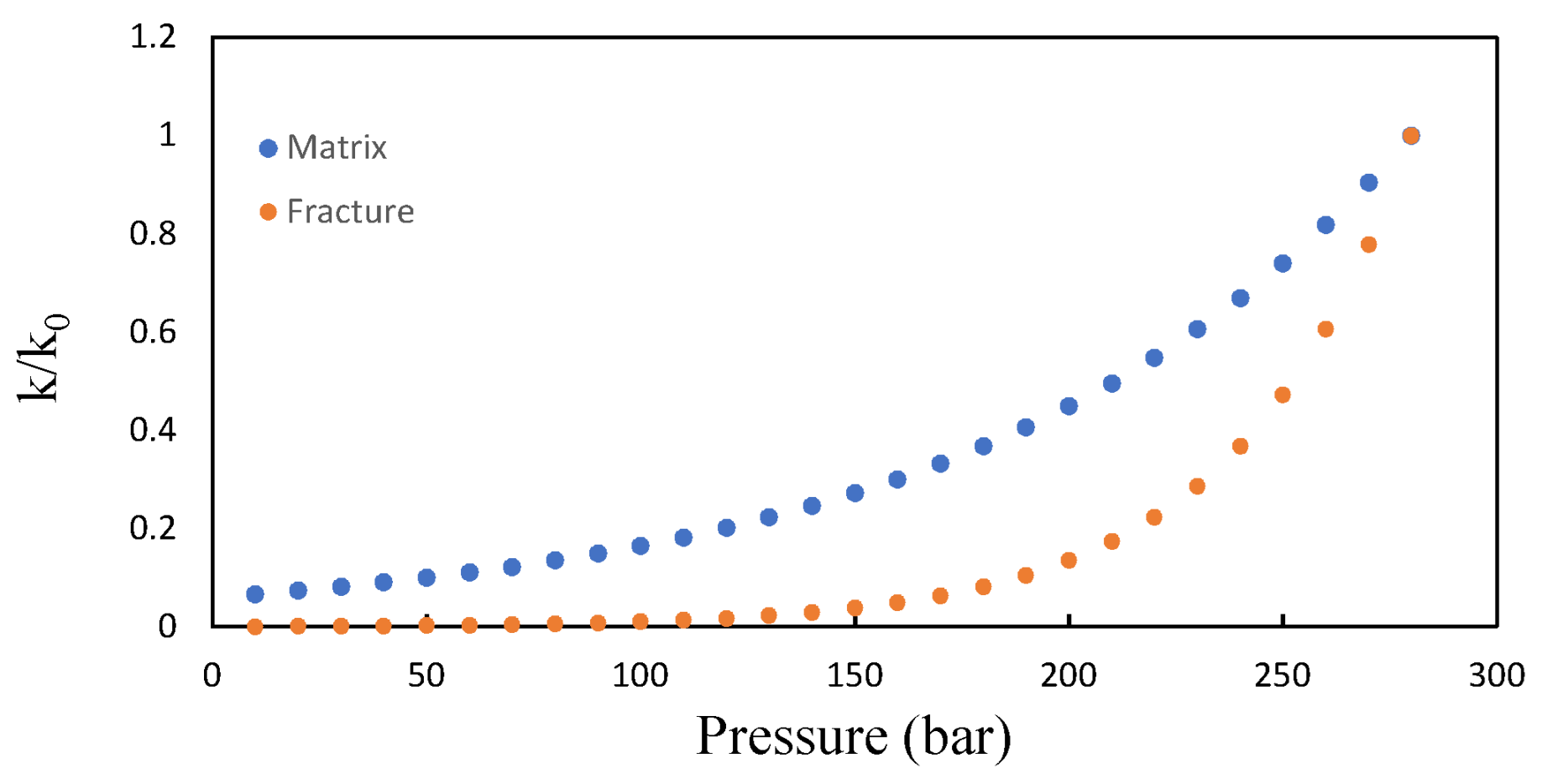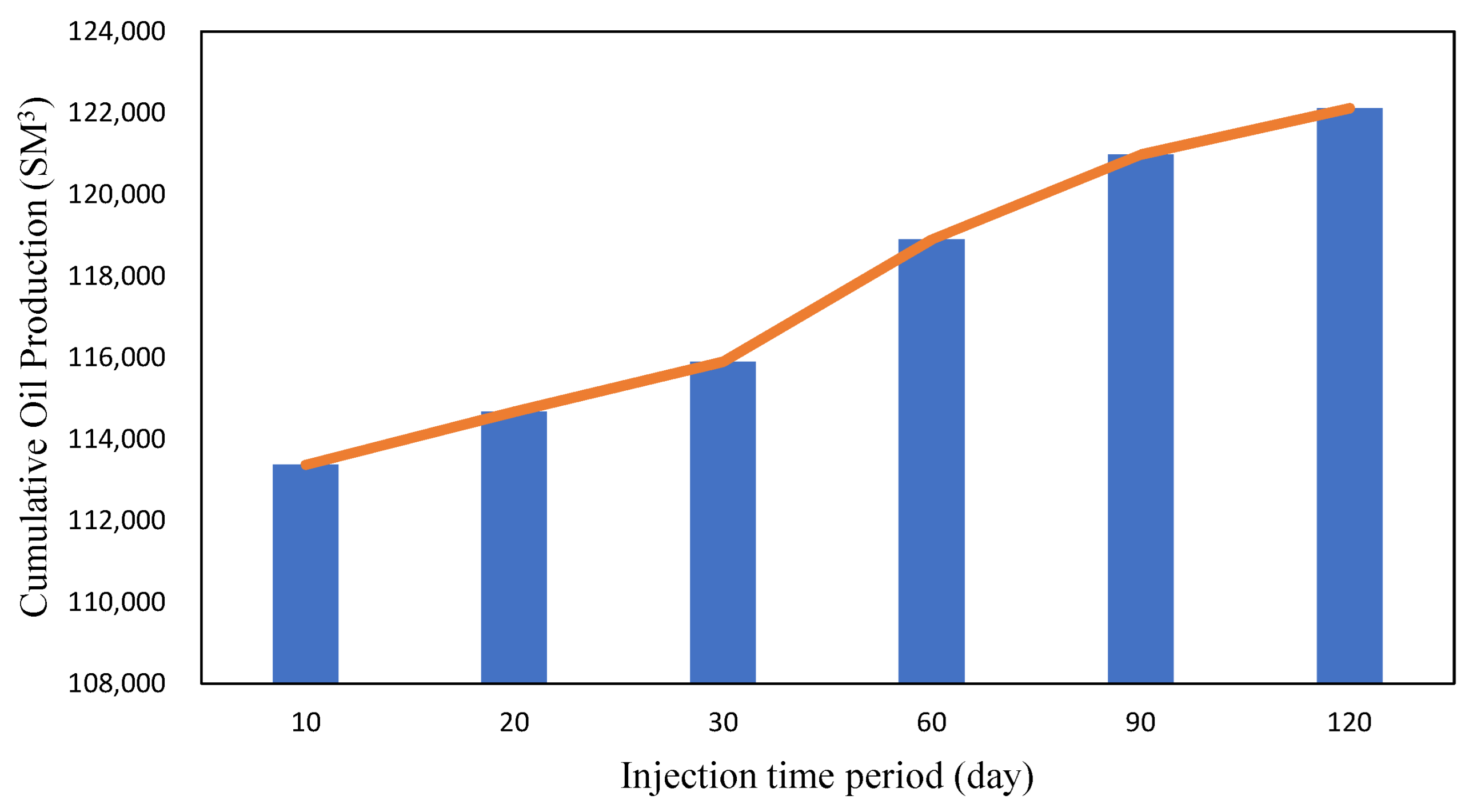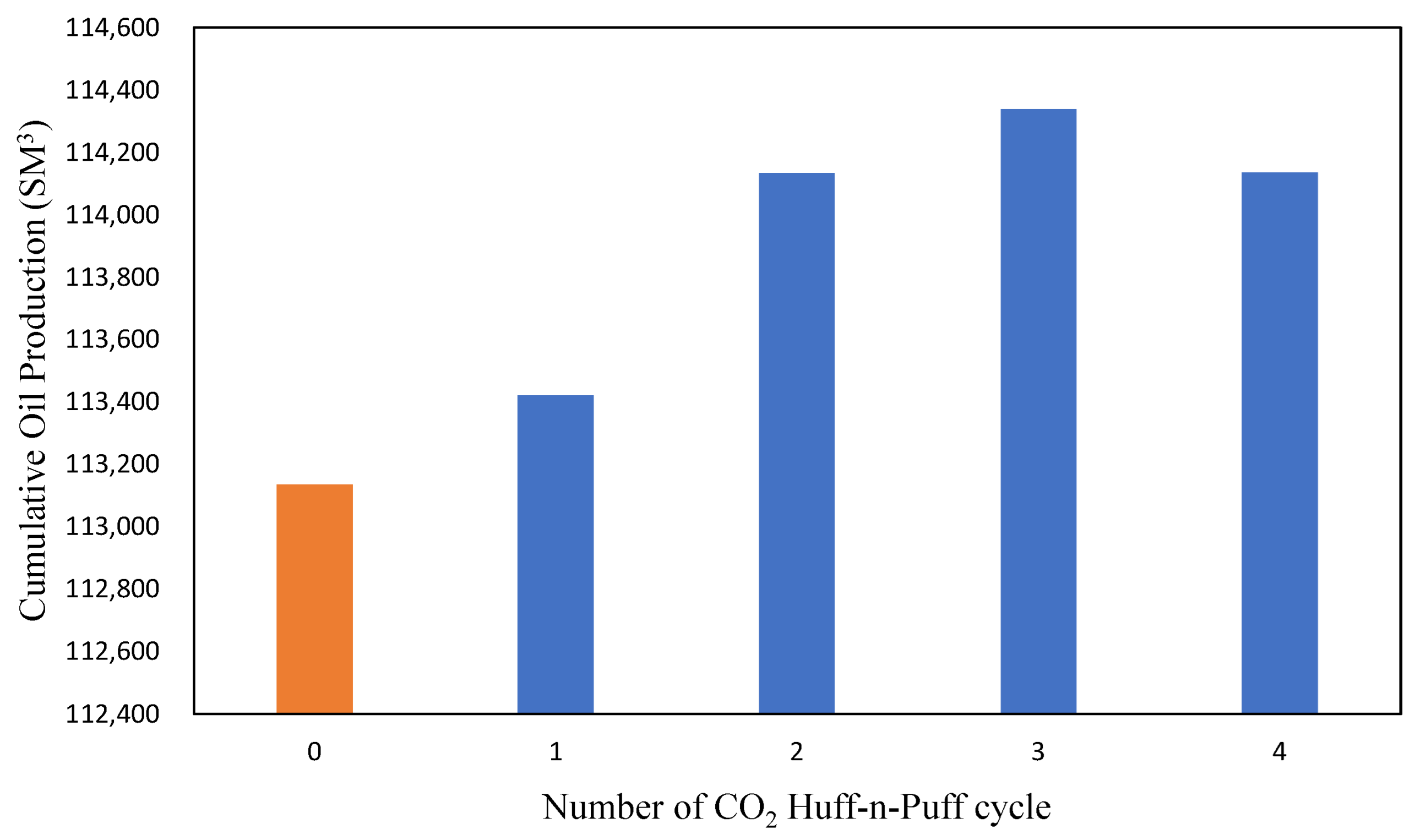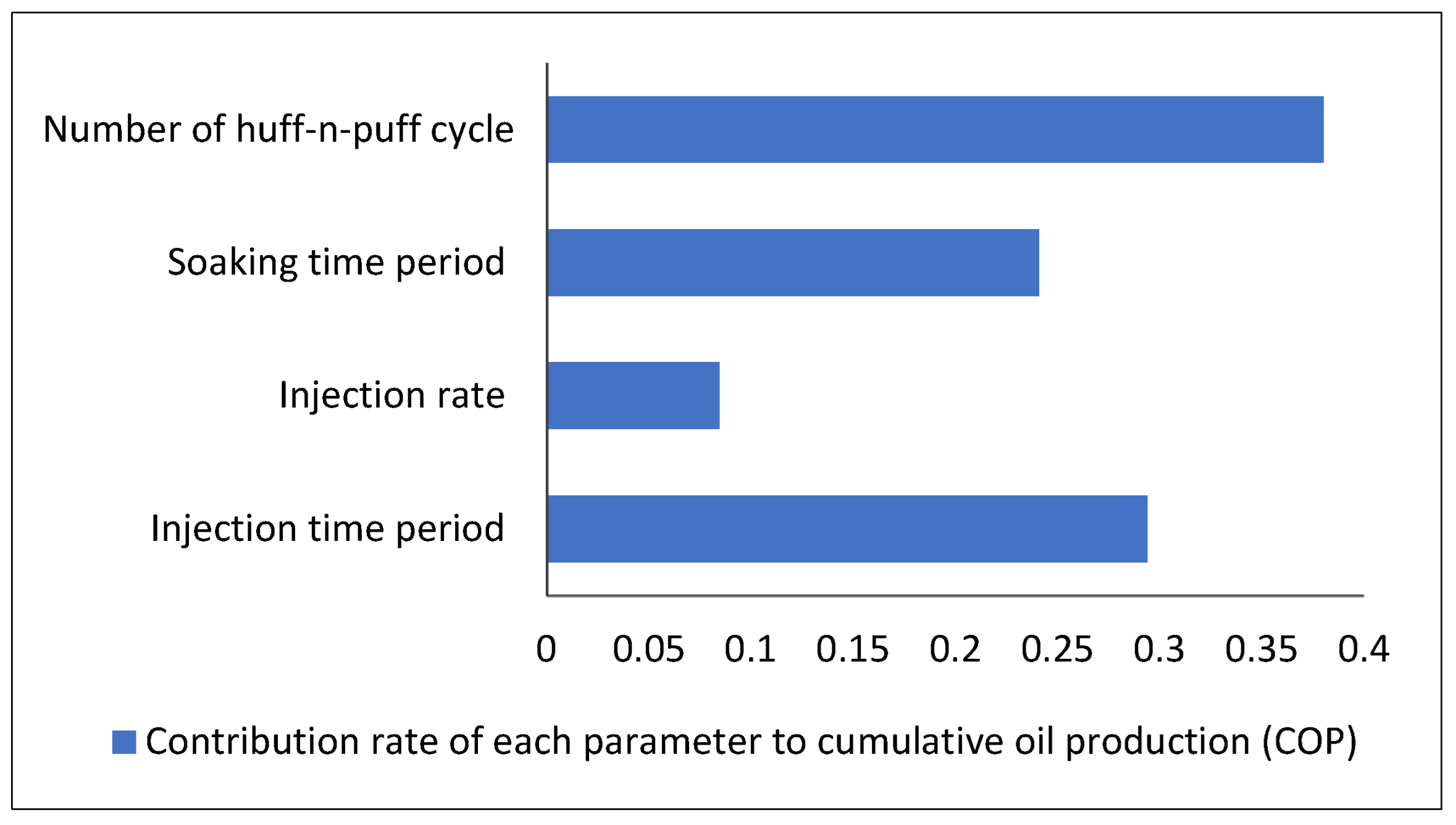Compositional Simulation of CO2 Huff-n-Puff Processes in Tight Oil Reservoirs with Complex Fractures Based on EDFM Technology Considering the Threshold Pressure Gradient
Abstract
:1. Introduction
2. Materials and Methods
2.1. Model Parameter Settings
2.2. Threshold Pressure Gradient and Stress Sensitivity
3. Results and Discussion
3.1. Sensitivity Parameter Analysis for CO2 Huff-n-Puff
3.1.1. Effect of Bottom-Hole Pressure
3.1.2. Effect of CO2 Injection Rate
3.1.3. Effect of Injection Time
3.1.4. Effect of Soaking Time
3.1.5. Effect of the Number of CO2 Huff-n-Puff Cycles
3.1.6. Comprehensive Analysis of Multiple Factors Affecting COP
4. Conclusions
- (1)
- The latest embedded discrete fracture technology (EDFM) was applied in the model, making the simulation of CO2 huff-n-puff in complex fractured reservoirs faster and more efficient.
- (2)
- The starting pressure gradient and rock stress sensitivity factors greatly affect the pressure field of tight reservoirs and the cumulative production of multistage-fracturing horizontal wells. The rock stress sensitivity influences the reservoir’s permeability and porosity, and the starting pressure gradient can interfere with the flow calculation of “matrix–matrix”, as well as the flow calculation of “matrix-fracture” and “embedded fracture–matrix”, which cannot be ignored in component numerical simulations.
- (3)
- In CO2 huff-n-puff simulations, production parameters such as injection rate, injection time, soak time, and the number of cycles all have an impact on COP. The degree of influence of the number of cycle accounts for 38.04%, the injection time accounts for 29.41%, the soaking time accounts for 24.10%, and the injection rate accounts for 8.45%. So, the number of cycles contributes the most to COP, followed by injection time and soak time, with the injection rate contributing the least. The injection rate and the number of cycles both have optimal values, while the injection time and soak time tend to have less significant effects on the growth of COP over time. Based on the results of our numerical simulations, the plan of injecting CO2 at a daily injection rate of 50,000 cubic meters for 20 days, soaking for 35 days, circulating for three rounds, and producing for 5 years can achieve the highest cumulative production.
- (4)
- This study provides a universal and more efficient numerical simulation method for CO2 huff-n-puff in multistage-fracturing horizontal wells of complex fractured tight oil reservoirs. The innovation of this study is the integration of nonlinear seepage with the starting pressure gradient, stress sensitivity, and EDFM technology.
Author Contributions
Funding
Data Availability Statement
Acknowledgments
Conflicts of Interest
References
- Weixiang, C.; Chunpeng, W. Carbon capture, utilization and storage (CCUS) in tight oil reservoir. In Proceedings of the Abu Dhabi International Petroleum Exhibition and Conference, Abu Dhabi, United Arab Emirates, 2 October 2023. [Google Scholar]
- Joslin, K.; Ghedan, S.G.; Abraham, A.M.; Pathak, V. EOR in tight reservoirs, technical and economical feasibility. In Proceedings of the SPE Unconventional Resources Conference, Calgary, AB, Canada, 15 February 2017. [Google Scholar]
- Todd, H.B.; Evans, J.G. Improved Oil Recovery IOR Pilot Projects in the Bakken Formation. In Proceedings of the SPE Low Perm Symposium, Denver, CO, USA, 5 May 2016. [Google Scholar]
- Kang, Y.; Tian, J.; Luo, P.; Liu, X. Technical bottlenecks and development straegies of enhancing recovery for tight oil reserviors. Acta Pet. Sin. 2020, 41, 468–479. [Google Scholar]
- Gale, J.F.W.; Laubach, S.E.; Olson, J.E.; Eichhubl, P.; Fall, A. Natural fractures in shale: A review and new observations. AAPG Bull. 2014, 98, 2165–2216. [Google Scholar] [CrossRef]
- Hu, T.; Pang, X.; Wang, X.; Pang, H.; Liu, Y.; Wang, Y.; Tang, L.; Chen, L.; Pan, Z.; Xu, J.; et al. Tight oil play characterisation: The lower-middle Permian Lucaogou Formation in the Jimusar Sag, Junggar Basin, Northwest China. Aust. J. Earth Sci. 2016, 63, 349–365. [Google Scholar] [CrossRef]
- Fisher, M.K.; Wright, C.A.; Davidson, B.M.; Goodwin, A.K.; Fielder, E.O.; Buckler, W.S.; Steinsberger, N.P. Integrating fracture mapping technologies to optimize stimulations in the Barnett Shale. In Proceedings of the SPE Annual Technical Conference and Exhibition, San Antonio, TX, USA, 29 September 2002. [Google Scholar]
- Xu, Y.; Cavalcante, J.S.A.; Yu, W.; Sepehrnoori, K. Discrete-fracture modeling of complex hydraulic-fracture geometries in reservoir simulators. SPE Reserv. Eval. Eng. 2017, 20, 403–422. [Google Scholar] [CrossRef]
- Moinfar, A.; Varavei, A.; Sepehrnoori, K.; Johns, R.T. Development of a novel and computationally-efficient discrete-fracture model to study ior processes in naturally fractured reservoirs. In Proceedings of the SPE Improved Oil Recovery Symposium, Tulsa, OK, USA, 14–18 April 2012. [Google Scholar]
- Barenblatt, G.I.; Zheltov, I.P.; Kochina, I. Basic concepts in the theory of seepage of homogeneous liquids in fissured rocks [strata]. J. Appl. Math. Mech. 1960, 24, 1286–1303. [Google Scholar] [CrossRef]
- Warren, J.E.; Root, P.J. The behavior of naturally fractured reservoirs. SPE J. 1963, 3, 245–255. [Google Scholar] [CrossRef]
- Dean, R.; Lo, L. Development of a natural fracture simulator and examples of its use. In Proceedings of the International Meeting on Petroleum Engineering, Beijing, China, 17–20 March 1986. [Google Scholar]
- Odling, N.; Gillespie, P.; Bourgine, B.; Castaing, C.; Chiles, J.; Christensen, N.; Fillion, E.; Genter, A.; Olsen, C.; Thrane, L. Variations in fracture system geometry and their implications for fluid flow in fractures hydrocarbon reservoirs. Petrol. Geosci. 1999, 5, 373–384. [Google Scholar] [CrossRef]
- Kazemi, H.; Merrill Jr, L.; Porterfield, K.; Zeman, P. Numerical simulation of water-oil flow in naturally fractured reservoirs. SPE J. 1976, 16, 317–326. [Google Scholar] [CrossRef]
- Rossen, R. Simulation of naturally fractured reservoirs with semi-implicit source terms. SPE J. 1977, 17, 201–210. [Google Scholar] [CrossRef]
- Blaskovich, F.; Cain, G.; Sonier, F.; Waldren, D.; Webb, S. A multicomponent isothermal system for efficient reservoir simulation. In Proceedings of the SPE Middle East Oil and Gas Show and Conference, Manama, Bahrain, 14 March 1983; p. SPE–11480-MS. [Google Scholar]
- Hill, A.; Thomas, G. A new approach for simulating complex fractured reservoirs. In Proceedings of the SPE Middle East Oil and Gas Show and Conference, Manama, Bahrain, 11–14 March 1985. [Google Scholar]
- Saidi, A. Simulation of naturally fractured reservoirs. In Proceedings of the SPE Reservoir Simulation Conference, San Francisco, CA, USA, 26–28 February 1983. [Google Scholar]
- Gillespie, P.; Howard, C.; Walsh, J.; Watterson, J. Measurement and characterisation of spatial distributions of fractures. Tectonophysics 1993, 226, 113–141. [Google Scholar] [CrossRef]
- Moinfar, A.; Narr, W.; Hui, M.-H.; Mallison, B.; Lee, S.H. Comparison of discrete-fracture and dual-permeability models for multiphase flow in naturally fractured reservoirs. In Proceedings of the SPE Reservoir Simulation Conference, Abu Dhabi, UAE, 9–11 October 2011. [Google Scholar]
- Al-Hinai, O.; Singh, G.; Pencheva, G.; Almani, T.; Wheeler, M.F. Modeling multiphase flow with nonplanar fractures. In Proceedings of the SPE Reservoir Simulation Symposium, The Woodlands, TX, USA, 18 February 2013. [Google Scholar]
- Hui, M.-H.R.; Mallison, B.; Heidary-Fyrozjaee, M.; Narr, W. The upscaling of discrete fracture models for faster, coarse-scale simulations of IOR and EOR processes for fractured reservoirs. In Proceedings of the SPE Annual Technical Conference and Exhibition, New Orleans, LA, USA, 1 October 2013. [Google Scholar]
- Karimi-Fard, M.; Durlofsky, L.J.; Aziz, K. An efficient discrete-fracture model applicable for general-purpose reservoir simulators. SPE J. 2004, 9, 227–236. [Google Scholar] [CrossRef]
- Monteagudo, J.E.P.; Firoozabadi, A. Control-volume method for numerical simulation of two-phase immiscible flow in two- and three-dimensional discrete-fractured media. Water Resour. Res. 2004, 40, W07405. [Google Scholar] [CrossRef]
- Noorishad, J.; Mehran, M. An upstream finite element method for solution of transient transport equation in fractured porous media. Water Resour. Res. 1982, 18, 588–596. [Google Scholar] [CrossRef]
- Olorode, O.M.M.; Freeman, C.M.M.; Moridis, G.J.J.; Blasingame, T.A.A. High-resolution numerical modeling of complex and irregular fracture patterns in shale-gas reservoirs and tight gas reservoirs. SPE Reserv. Eval. Eng. 2013, 16, 443–455. [Google Scholar] [CrossRef]
- Sandve, T.H.; Berre, I.; Nordbotten, J.M. An efficient multi-point flux approximation method for Discrete Fracture–Matrix simulations. J. Comput. Phys. 2012, 231, 3784–3800. [Google Scholar] [CrossRef]
- Li, L.; Lee, S.H. Efficient field-scale simulation of black oil in a naturally fractured reservoir through discrete fracture networks and homogenized media. SPE Reserv. Eval. Eng. 2008, 11, 750–758. [Google Scholar] [CrossRef]
- Qin, J.; Xu, Y.; Tang, Y.; Liang, R.; Zhong, Q.; Yu, W.; Sepehrnoori, K. Impact of complex fracture networks on rate transient behavior of wells in unconventional reservoirs based on embedded discrete fracture model. J. Energy Resour. Technol. 2021, 144, 083007. [Google Scholar] [CrossRef]
- Shakiba, M.; Sepehrnoori, K. Using embedded discrete fracture model (EDFM) and microseismic monitoring data to characterize the complex hydraulic fracture networks. In Proceedings of the SPE Annual Technical Conference and Exhibition, Houston, TX, USA, 30 September 2015. [Google Scholar]
- Lee, S.H.; Jensen, C.L.; Lough, M.F. Efficient finite-difference model for flow in a reservoir with multiple length-scale fractures. SPE J. 2000, 5, 268–275. [Google Scholar] [CrossRef]
- Li, J.; Tang, H.; Zhang, Y.; Li, X. An adaptive grid refinement method for flow-based embedded discrete fracture models. In Proceedings of the SPE Reservoir Simulation Conference, Galveston, TX, USA, 21 March 2023. [Google Scholar]
- Fiallos, M.X.; Yu, W.; Ganjdanesh, R.; Kerr, E.; Sepehrnoori, K.; Miao, J.; Ambrose, R. Modeling interwell interference due to complex fracture hits in eagle ford using EDFM. In Proceedings of the International Petroleum Technology Conference, Beijing, China, 26 March 2019. [Google Scholar]
- Yu, W.; Lashgari, H.R.; Wu, K.; Sepehrnoori, K. CO2 injection for enhanced oil recovery in Bakken tight oil reservoirs. Fuel 2015, 159, 354–363. [Google Scholar] [CrossRef]
- Askarova, A.; Turakhanov, A.; Mukhina, E.; Cheremisin, A.; Cheremisin, A. Unconventional reservoirs: Methodological approaches for thermal EOR simulation. In Proceedings of the SPE/AAPG/SEG Unconventional Resources Technology Conference, Virtual, 22 July 2020. [Google Scholar]
- Khakimova, L.; Askarova, A.; Popov, E.; Moore, R.G.; Solovyev, A.; Simakov, Y.; Afanasiev, I.; Belgrave, J.; Cheremisin, A. High-pressure air injection laboratory-scale numerical models of oxidation experiments for Kirsanovskoye oil field. J. Pet. Sci. Eng. 2020, 188, 106796. [Google Scholar] [CrossRef]
- Lee, K.; Moridis, G.J.; Ehlig-Economides, C.A. A Comprehensive simulation model of kerogen pyrolysis for the in-situ upgrading of oil shales. SPE J. 2016, 21, 1612–1630. [Google Scholar] [CrossRef]
- Liu, J.; Chen, H.; Zhao, S.; Pan, P.; Wu, L.; Xu, G. Evaluation and improvements on the flexibility and economic performance of a thermal power plant while applying carbon capture, utilization & storage. Energy Conv. Manag. 2023, 290, 117219. [Google Scholar]
- Mukhina, E.; Askarova, A.; Kalacheva, D.; Leushina, E.; Kozlova, E.; Cheremisin, A.; Morozov, N.; Dvoretskaya, E.; Demo, V.; Cheremisin, A. Hydrocarbon saturation for an unconventional reservoir in details. In Proceedings of the SPE Russian Petroleum Technology Conference, Moscow, Russia, 24 October 2019. [Google Scholar]
- He, T.; Li, W.; Lu, S.; Yang, E.; Jing, T.; Ying, J.; Zhu, P.; Wang, X.; Pan, W.; Zhang, B.; et al. Quantitatively unmixing method for complex mixed oil based on its fractions carbon isotopes: A case from the Tarim Basin, NW China. Petrol. Sci. 2023, 20, 102–113. [Google Scholar] [CrossRef]
- Liu, S.; Sahni, V.; Tan, J.; Beckett, D.; Vo, T. Laboratory investigation of eor techniques for organic rich shales in the permian basin. In Proceedings of the SPE/AAPG/SEG Unconventional Resources Technology Conference, Houston, TX, USA, 25 July 2018. [Google Scholar]
- Sennaoui, B.; Pu, H.; Malki, M.L.; Afari, A.S.; Larbi, A. Reservoir simulation study and optimizations of CO2 huff-n-puff mechanisms in three forks formation. In Proceedings of the International Geomechanics Symposium, Abu Dhabi, UAE, 7 November 2022. [Google Scholar]
- Erofeev, A.A.; Mitrushkin, D.A.; Meretin, A.S.; Pachezhertsev, A.A.; Karpov, I.A.; Demo, V.O. Simulation of thermal recovery methods for development of the bazhenov formation. In Proceedings of the SPE Russian Petroleum Technology Conference and Exhibition, Moscow, Russia, 24 October 2016. [Google Scholar]
- Kang, Z.; Zhao, Y.; Yang, D. Review of oil shale in-situ conversion technology. Appl. Energy 2020, 269, 115121. [Google Scholar] [CrossRef]
- Hassan, A.M.; Ayoub, M.; Eissa, M.; Al-Shalabi, E.W.; Almansour, A.; Alquraishi, A. Foamability and foam stability screening for smart water assisted foam flooding: A new hybrid eor method. In Proceedings of the International Petroleum Technology Conference, Riyadh, Saudi Arabia, 22 February 2022. [Google Scholar]
- Downey, R.; Venepalli, K.; Erdle, J.; Whitelock, M. A superior shale oil eor method for the permian basin. In Proceedings of the SPE Annual Technical Conference and Exhibition, Dubai, United Arab Emirates, 22 September 2021. [Google Scholar]
- Rezaei Koochi, M.; Mehrabi-Kalajahi, S.; Varfolomeev, M.A. Thermo-Gas-Chemical stimulation as a revolutionary ior-eor method by the in-situ generation of hot nitrogen and acid. In Proceedings of the SPE Annual Technical Conference and Exhibition, Dubai, United Arab Emirates, 22 September 2021. [Google Scholar]
- Holm, L.; Josendal, V. Mechanisms of oil displacement by carbon dioxide. J. Pet. Technol. 1974, 26, 1427–1438. [Google Scholar] [CrossRef]
- Holm, W.L. Evolution of the carbon dioxide flooding processes. J. Pet. Technol. 1987, 39, 1337–1342. [Google Scholar] [CrossRef]
- Strack, K.; Barajas-Olalde, C.; Davydycheva, S.; Martinez, Y.; Paembonan, A. CCUS plume monitoring: Verifying surface csem measurements to log scale. In Proceedings of the SPWLA 64th Annual Logging Symposium, Lake Conroe, TX, USA, 13 June 2023. [Google Scholar]
- Paskvan, F.; Paine, H.; Resler, C.; Sheets, B.; McGuire, T.; Connors, K.; Tempel, E. Alaska CCUS workgroup and a roadmap to commercial deployment. In Proceedings of the SPE Western Regional Meeting, Anchorage, AK, USA, 24 May 2023. [Google Scholar]
- Bao, X.; Fragoso, A.; Aguilera, R. CCUS and comparison of oil recovery by huff n puff gas injection using methane, carbon dioxide, hydrogen and rich gas in shale oil reservoirs. In Proceedings of the SPE Canadian Energy Technology Conference and Exhibition, Calgary, AB, Canada, 16 March 2023. [Google Scholar]
- Halinda, D.; Zariat, A.A.; Muraza, O.; Marteighianti, M.; Setyawan, W.; Haribowo, A.; Rajab, M.; Firmansyah, M.; Hasan, I.; Nurlia, D.; et al. CO2 huff and puff injection operation overview in jatibarang field lessons learned from a successful case study in mature oil field. In Proceedings of the Abu Dhabi International Petroleum Exhibition and Conference, Abu Dhabi, United Arab Emirates, 2 October 2023. [Google Scholar]
- Zhao, J.; Jin, L.; Azzolina, N.A.; Wan, X.; Yu, X.; Sorensen, J.A.; Kurz, B.A.; Bosshart, N.W.; Smith, S.A.; Wu, C.; et al. Investigating enhanced oil recovery in unconventional reservoirs based on field case review, laboratory, and simulation studies. Energ. Fuel 2022, 36, 14771–14788. [Google Scholar] [CrossRef]
- Sun, Y.; Li, S.; Sun, R.; Liu, X.; Pu, H.; Zhao, J. Study of CO2 enhancing shale gas recovery based on competitive adsorption theory. ACS Omega 2020, 5, 23429–23436. [Google Scholar] [CrossRef]
- Wang, T.; Xu, B.; Chen, Y.T.; Wang, J. Mechanism and main control factors of CO2 huff and puff to enhance oil recovery in chang 7 shale oil reservoir of Ordos Basin. Processes 2023, 11, 2726. [Google Scholar] [CrossRef]
- Zhang, S.; Jia, B.; Zhao, J.; Pu, H. A diffuse layer model for hydrocarbon mass transfer between pores and organic matter for supercritical CO2 injection and sequestration in shale. Chem. Eng. J. 2021, 406, 126746. [Google Scholar] [CrossRef]
- Li, L.; Su, Y.; Sheng, J.J.; Hao, Y.; Wang, W.; Lv, Y.; Zhao, Q.; Wang, H. Experimental and numerical study on CO2 sweep volume during CO2 huff-n-puff enhanced oil recovery process in shale oil reservoirs. Energ. Fuel 2019, 33, 4017–4032. [Google Scholar] [CrossRef]
- El Morsy, M.; Ali, S.; Giddins, M.A.; Fitch, P. CO2 injection for improved recovery in tight gas condensate reservoirs. In Proceedings of the SPE Asia Pacific Oil & Gas Conference and Exhibition, Virtual, 19 November 2020. [Google Scholar]
- Seteyeobot, I.; Jamiolahmady, M.; Doryanidaryuni, H.; Molokwu, V. A Coreflood simulation study of a systematic CO2 huff-n-puff injection for storage and enhanced gas condensate recovery. In Proceedings of the SPE Annual Technical Conference and Exhibition, Houston, TX, USA, 5 October 2022. [Google Scholar]
- Zhang, Y.; Yu, W.; Li, Z.; Sepehrnoori, K. Simulation study of factors affecting CO2 Huff-n-Puff process in tight oil reservoirs. J. Pet. Sci. Eng. 2018, 163, 264–269. [Google Scholar] [CrossRef]
- Zhao, J.; Wang, P.; Yang, H.; Tang, F.; Ju, Y.; Jia, Y. Experimental investigation of the CO2 huff and puff effect in low-permeability sandstones with NMR. ACS Omega 2021, 6, 15601–15607. [Google Scholar] [CrossRef] [PubMed]
- Lei, Z.; Wu, S.; Yu, T.; Ping, Y.; Qin, H.; Yuan, J.; Zhu, Z.; Su, H. Simulation and optimization of CO2 huff-n-puff processes in tight oil reservoir: A case study of Chang-7 tight oil reservoirs in Ordos Basin. In Proceedings of the SPE Asia Pacific Oil and Gas Conference and Exhibition, Jakarta, Indonesia, 24 October 2018. [Google Scholar]
- Alfarge, D.; Wei, M.; Bai, B. Chapter 3—Comparative analysis between CO2-EOR mechanisms in conventional reservoirs versus shale and tight reservoirs. In Developments in Petroleum Science; Elsevier: Amsterdam, The Netherlands, 2020; Volume 67, pp. 45–63. [Google Scholar]
- Cao, M.; Wu, X.; An, Y.; Zuo, Y.; Wang, R.; Li, P. Numerical simulation and performance evaluation of CO2 huff-n-puff processes in unconventional oil reservoirs. In Proceedings of the Carbon Management Technology Conference, Houston, TX, USA, 17 July 2017. [Google Scholar]
- Kurtoglu, B.; Sorensen, J.A.; Braunberger, J.; Smith, S.; Kazemi, H. Geologic characterization of a bakken reservoir for potential CO2 EOR. In Proceedings of the SPE/AAPG/SEG Unconventional Resources Technology Conference, Denver, CO, USA, 12–14 August 2013. [Google Scholar]
- Li, X.; Zhang, D.; Li, S. A multi-continuum multiple flow mechanism simulator for unconventional oil and gas recovery. J. Nat. Gas. Sci. Eng. 2015, 26, 652–669. [Google Scholar] [CrossRef]















| Parameter | Value | Unit |
|---|---|---|
| Model size (x × y × z) | 2000 × 1000 × 40 | m |
| Number of grid blocks (x × y × z) | 50 × 25 × 5 | – |
| Reservoir permeability | 0.01 | mD |
| Reservoir porosity | 15% | – |
| Rock compressibility | 9.72 × 10−5 | bar−1 |
| Reservoir thickness | 40 | m |
| Well length | 1200 | m |
| Fracture half-length | 150 | m |
| Fracture height | 40 | m |
| Fracture permeability | 2000 | mD |
| Component | Molar Fraction | Critical Pressure (Bar) | Critical Temperature (K) | Critical Volume (m3/kg⸱mol) | Molecular Weigh | Acentric Factor | Parachor Coefficient |
|---|---|---|---|---|---|---|---|
| CO2 | 0.0172 | 73.866 | 304.7 | 0.094000661 | 44.01 | 0.225 | 78 |
| N2 | 0.014 | 33.944 | 126.2 | 0.089999236 | 28.013 | 0.04 | 41 |
| C1 | 0.1958 | 46.042 | 190.6 | 0.098000352 | 16.043 | 0.013 | 77 |
| C2 | 0.0736 | 48.839 | 305.43 | 0.14799645 | 30.07 | 0.0986 | 108 |
| C3–C5 | 0.1302 | 42.455 | 369.8 | 0.19999748 | 44.097 | 0.1524 | 150.3 |
| C6 | 0.2606 | 30.104 | 507.5 | 0.35099954 | 84 | 0.299 | 271 |
| C7 | 0.23 | 29.384 | 548 | 0.39200317 | 96 | 0.3 | 312.5 |
| C8 | 0.0786 | 28.797 | 575 | 0.43299929 | 107 | 0.312 | 351.5 |
| Component | CO2 | N2 | C1 | C2 | C3–C5 | C6 | C7 | C8 |
|---|---|---|---|---|---|---|---|---|
| CO2 | 0 | −0.012 | 0.1 | 0.1 | 0.1 | 0.1 | 0.1 | 0.1 |
| N2 | −0.012 | 0 | 0.1 | 0.1 | 0.1 | 0.1 | 0.1 | 0.1 |
| C1 | 0.1 | 0.1 | 0 | 0 | 0 | 0.0279 | 0.03308 | 0.0363 |
| C2 | 0.1 | 0.1 | 0 | 0 | 0 | 0.01 | 0.01 | 0.01 |
| C3–C5 | 0.1 | 0.1 | 0 | 0 | 0 | 0.01 | 0.01 | 0.01 |
| C6 | 0.1 | 0.1 | 0.0279 | 0.01 | 0.01 | 0 | 0 | 0 |
| C7 | 0.1 | 0.1 | 0.03308 | 0.01 | 0.01 | 0 | 0 | 0 |
| C8 | 0.1 | 0.1 | 0.0363 | 0.01 | 0.01 | 0 | 0 | 0 |
| Bottom-Hole Pressure (Bar) | Injection Rate (m3/day) | Injection Time Period (Day) | Soaking Time Period (Day) |
|---|---|---|---|
| 200 | 50,000 | 30 | 30 |
| 180 | 50,000 | 30 | 30 |
| 150 | 50,000 | 30 | 30 |
| 100 | 50,000 | 30 | 30 |
| 80 | 50,000 | 30 | 30 |
| 75 | 50,000 | 30 | 30 |
| Injection Rate (m3/day) | Injection Time Period (Day) | Soaking Time Period (Day) | Number of CO2 Huff-n-Puff Cycles |
|---|---|---|---|
| 40,000 | 15 | 30 | 4 |
| 50,000 | 12 | 30 | 4 |
| 60,000 | 10 | 30 | 4 |
| 100,000 | 6 | 30 | 4 |
| Injection Rate (m3/day) | Injection Time Period (Day) | Soaking Time Period (Day) | Number of Huff-n-Puff Cycles |
|---|---|---|---|
| 50,000 | 10 | 30 | 4 |
| 50,000 | 20 | 30 | 4 |
| 50,000 | 30 | 30 | 4 |
| 50,000 | 60 | 30 | 4 |
| 50,000 | 90 | 30 | 4 |
| 50,000 | 120 | 30 | 4 |
| Injection Rate (m3/day) | Injection Time Period (Day) | Soaking Time Period (Day) | Number of Huff-n-Puff Cycles |
|---|---|---|---|
| 50,000 | 20 | 10 | 4 |
| 50,000 | 20 | 15 | 4 |
| 50,000 | 20 | 20 | 4 |
| 50,000 | 20 | 30 | 4 |
| 50,000 | 20 | 35 | 4 |
| 50,000 | 20 | 40 | 4 |
| Injection Rate (m3/day) | Injection Time Period (Day) | Soaking Time Period (Day) | Number of Huff-n-Puff Cycles |
|---|---|---|---|
| 50,000 | 20 | 35 | 0 |
| 50,000 | 20 | 35 | 1 |
| 50,000 | 20 | 35 | 2 |
| 50,000 | 20 | 35 | 3 |
| 50,000 | 20 | 35 | 4 |
Disclaimer/Publisher’s Note: The statements, opinions and data contained in all publications are solely those of the individual author(s) and contributor(s) and not of MDPI and/or the editor(s). MDPI and/or the editor(s) disclaim responsibility for any injury to people or property resulting from any ideas, methods, instructions or products referred to in the content. |
© 2023 by the authors. Licensee MDPI, Basel, Switzerland. This article is an open access article distributed under the terms and conditions of the Creative Commons Attribution (CC BY) license (https://creativecommons.org/licenses/by/4.0/).
Share and Cite
Zheng, J.; Jiang, T.; Chen, X.; Cui, Z.; Jiang, S.; Song, F.; Wen, Z.; Wang, L. Compositional Simulation of CO2 Huff-n-Puff Processes in Tight Oil Reservoirs with Complex Fractures Based on EDFM Technology Considering the Threshold Pressure Gradient. Energies 2023, 16, 7538. https://doi.org/10.3390/en16227538
Zheng J, Jiang T, Chen X, Cui Z, Jiang S, Song F, Wen Z, Wang L. Compositional Simulation of CO2 Huff-n-Puff Processes in Tight Oil Reservoirs with Complex Fractures Based on EDFM Technology Considering the Threshold Pressure Gradient. Energies. 2023; 16(22):7538. https://doi.org/10.3390/en16227538
Chicago/Turabian StyleZheng, Jiayu, Tianhao Jiang, Xiaoxia Chen, Zhengpan Cui, Shan Jiang, Fangxin Song, Zhigang Wen, and Lei Wang. 2023. "Compositional Simulation of CO2 Huff-n-Puff Processes in Tight Oil Reservoirs with Complex Fractures Based on EDFM Technology Considering the Threshold Pressure Gradient" Energies 16, no. 22: 7538. https://doi.org/10.3390/en16227538




